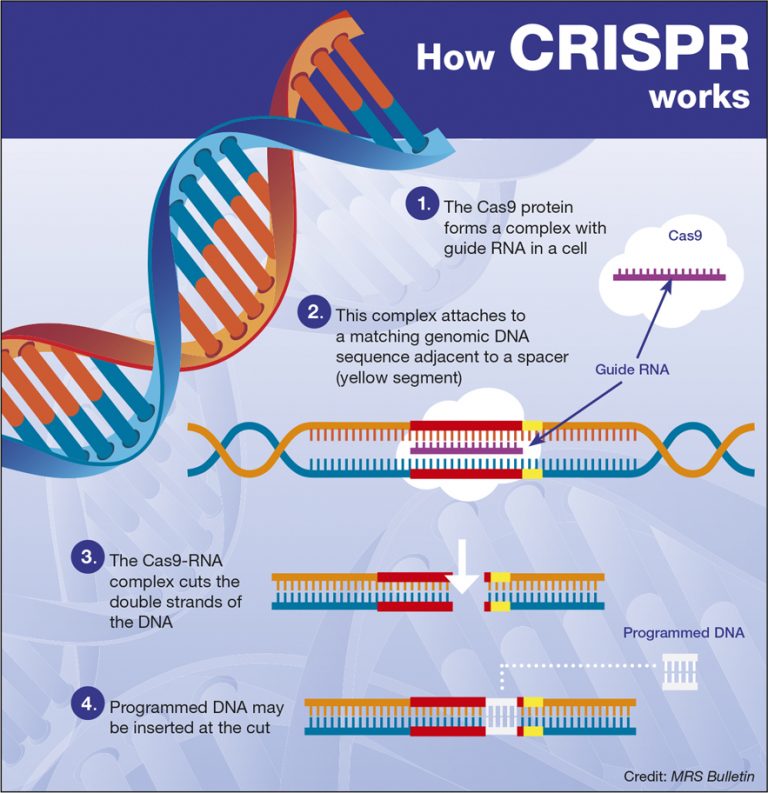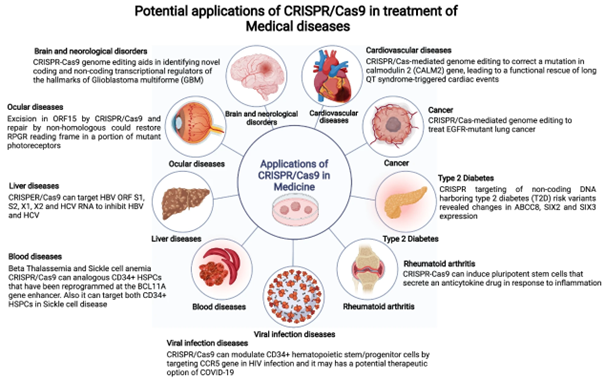
Paul
Blyth
Head of Underwriting and Claims Proposition, SCOR UK & Ireland

13 novembre 2024
CRISPR (Clustered Regularly Interspaced Short Palindromic Repeats) is a revolutionary genetic engineering technology that has taken the world of biotechnology by storm. It allows for precise, efficient, and cost-effective editing of Deoxyribonucleic acid (DNA) sequences, making it possible to modify genes and change the characteristics of an organism. The technology was first discovered in bacteria as a defence mechanism against invading viruses and has since been adapted for use in various fields, including agriculture, industrial biotechnology, and most notably, healthcare.
CRISPR includes several types of CRISPR-Cas systems, which differ in their components and mechanisms of action. The most well-known and widely used type is CRISPR-Cas9, which consists of a guide Ribonucleic acid (RNA) and a Cas9 protein. The guide RNA molecule is designed to target a specific DNA sequence, and when combined with Cas9, allows the enzyme to cut the DNA at the targeted location. This cutting allows for the removal or replacement of specific genes or DNA sequences, making the CRISPR system a powerful tool for genetic engineering. Other types, such as CRISPR-Cas12 and CRISPR-Cas13, use different Cas proteins to target and cut DNA or RNA.
Prime Editing is a newer form of CRISPR that allows for more precise and efficient editing of DNA sequences. It uses a modified Cas9 protein and a prime editing guide RNA (pegRNA) to make precise changes to the DNA without cutting both strands.
There are also several other variations and modifications of CRISPR being developed and tested for different applications, such as CRISPRi for gene silencing and base editors for targeted single-base changes.

One of the most significant applications of CRISPR technology is in the development of new treatments for genetic diseases. The technology potentially could be used to correct genetic mutations that cause inherited diseases such as Sickle Cell Anaemia, Cystic Fibrosis, and Huntington's disease, where trials are already underway. It has also shown promise in the treatment of cancer, where it can be used to manipulate cancer cells and improve the efficacy of cancer therapies. In addition, CRISPR can be used to study the function of genes and to understand the underlying mechanisms of complex diseases, such as neurological disorders.
An example of this new technology in clinical practice is the case of a young girl called Alyssa from Leicester, who was diagnosed with an aggressive T-cell acute lymphoblastic leukaemia in 2021. She had received chemotherapy and then underwent a bone-marrow transplant, which sadly proved ineffective.
In the past, the only option would have been to provide palliative treatment and keep Alyssa as comfortable as possible for as long as possible. However, a team at Great Ormond Street Hospital helped Alyssa receive ‘universal’ CAR T-cells that had been pre-manufactured from a healthy volunteer donor. She is the first person in the world to receive base-edited cell therapy1.
These cells had been gene-edited using a new CRISPR base-editing technology (like CRISPRi mentioned above) and fitted with a Chimeric Antigen Receptor (CAR) that allow them to recognise, hunt down and kill cancerous T-cells without attacking each other.
CRISPR Base-editing works by enzymatically converting the molecules that make up DNA, called nucleotide bases. This is different to CRISPR/Cas9 that uses molecular 'scissors' to cut and edit DNA. The new base editing approach acts without causing double-stranded breaks in the DNA, allowing more edits to be made.
28 days after having the CAR-T cell infusion, Alyssa was showing signs of remission. This allowed her to have a second bone-marrow transplant with the aim of restoring her immune system. Although Alyssa currently remains cancer free, it is still very early days. She will remain under constant follow up to monitor for any recurrence. However, the results to date are very promising.
For more information on CAR-T cell therapy, please see the article from September 2022’s SCORacle here.
Another area where CRISPR has shown promise is in the development of new vaccines and therapies for infectious diseases. For example, researchers are using CRISPR to create new vaccines for diseases like HIV, tuberculosis, and Zika virus. The technology can also be used to modify immune cells to make them more effective at fighting diseases like cancer, HIV, and other infectious diseases.
CRISPR has also been used in the field of regenerative medicine, where it can be used to stimulate the growth and repair of damaged tissues. Researchers are using CRISPR to induce the growth of new blood vessels, heart tissue, and other types of cells, which could have a significant impact on the treatment of diseases like heart disease and stroke.
In addition to its potential therapeutic applications, CRISPR also has significant implications for the future of personalised medicine. The technology can be used to analyse an individual’s genetic code and determine their risk of developing certain diseases. This information can then be used to develop tailored treatments and therapies that are optimised for each person.
The list of diseases currently being combated by CRISPR has been growing every day.
In addition to the fantastic story of Alyssa, data from clinical trials released recently has demonstrated that CRISPR therapy has been successful in treating patients with sickle cell anaemia as well as beta thalassaemia.
With the recent development of prime editing, which allows targeted small insertions, deletions, and base swapping in a precise way, scientists are excited to add a new tool to the genome editing toolbox, ushering in the promise of additional treatment options.
According to data from recent clinical trials, the CRISPR/Cas9 system has been used to generate disease-based models for many important human diseases, including viral diseases, neurological diseases (including Huntington’s disease), cancer, ocular disease, blood diseases, and cardiovascular diseases and disorders, as well as other complex genetic human diseases.

Despite its numerous potential applications, CRISPR also raises important ethical and safety concerns. One of the biggest concerns is the potential for off-target effects, where changes are made to the genome that could result in consequences that were not intended. Another concern is the possibility of creating new diseases or conditions by altering the human genome which could have far-reaching consequences for future generations.
To address these concerns, it is important to have regulation and oversight in place for the use of CRISPR technology. This may include guidelines for the ethical use of CRISPR, as well as measures to ensure the safety and security of the technology. For example, researchers and institutions that use CRISPR could be required to adhere to strict protocols and to conduct thorough risk assessments before conducting any experiments.
SCORs CMO Dr Rooney makes the following comments with regards to CRISPR:
"Clinical medicine is changing. The Central Dogma states that genetic information is transferred from DNA to RNA to protein. Defects in the DNA frequently occur. The abnormality is sometimes present at birth but alternatively can be acquired later in life. Regardless, defects can result in disease, suffering, and in many cases early death. This is mainly because of the abnormal protein (too much, too little, or abnormal function) that occurs. Traditionally, clinical medicine has dealt with these abnormal proteins. However, with CRISPR and other DNA and RNA editing techniques, the door is now opened for additional ways to treat the abnormality and in some cases cure the condition. Now, instead of managing symptoms, the cause itself is being addressed. This can favourably impact not only the quality but also the duration of life. This will clearly have an impact on Life insurance. Paying close attention to these technological advances is imperative to be able to appropriately offer affordable insurance to more people."
The impact of CRISPR for protection products is similar to other important medical developments. Specifically, CRISPR has the potential to lower the mortality risk of serious diseases and in some examples, to allow cover where currently this is not possible. In addition, there are many conditions where the morbidity risk would equally be reduced. The list of conditions above shows the wide spectrum of medical conditions where CRISPR could make a fantastic difference.
Another interesting dynamic that is created by CRISPR relates to restrictions of using genetic information imposed on insurers via regulation in the UK through the Association of British Insurers Code on Genetic Testing and Insurance, and the Disability Act 2005 in Ireland. Although, it will be some time before many of the CRISPR developments become mainstream to impact more significantly, in time they will reduce the risk for insurers from anti-selection, when the outlook for some of the genetic and familial conditions will have a much better prognosis.
In conclusion, CRISPR is a powerful tool for editing DNA sequences that has the potential to bring numerous benefits to society. While there are important ethical and safety considerations that need to be considered, the potential benefits of CRISPR technology make it a promising area of research and development. With the right regulation and oversight in place, CRISPR has the potential to revolutionise the field of genetics and bring significant advances to many areas of society, including medicine, agriculture, and biotechnology.
CONTACT
OUR EXPERT

Paul
Blyth
Head of Underwriting and Claims Proposition, SCOR UK & Ireland